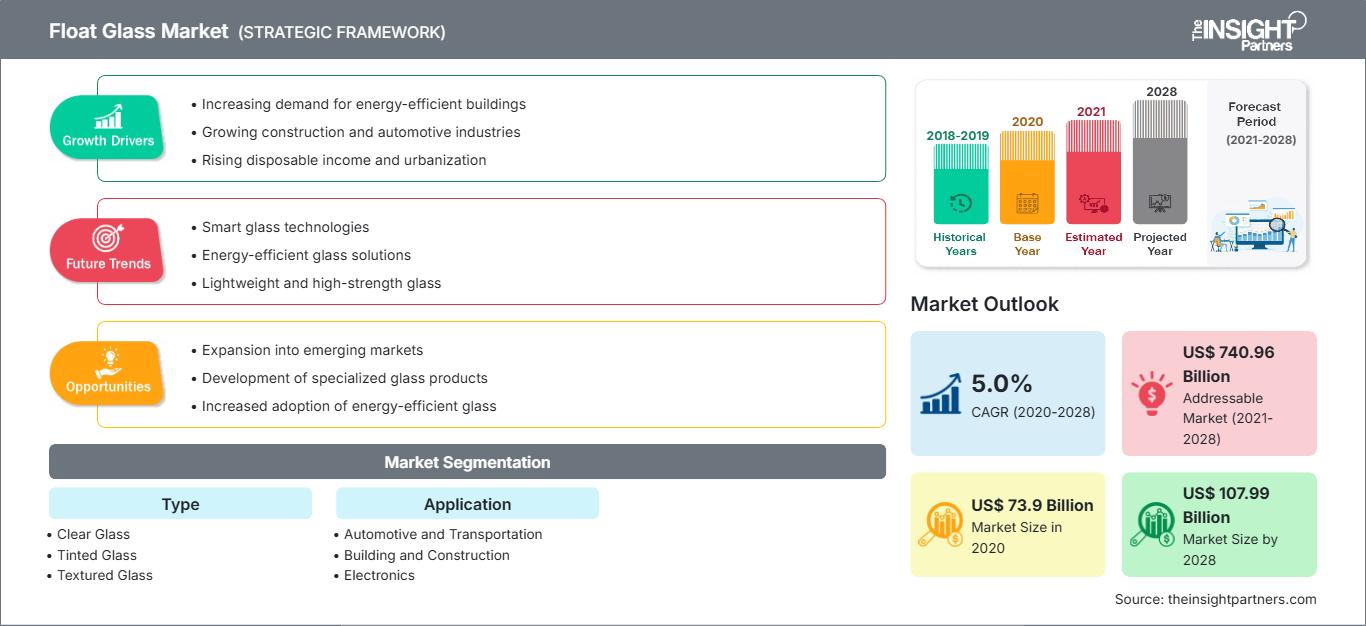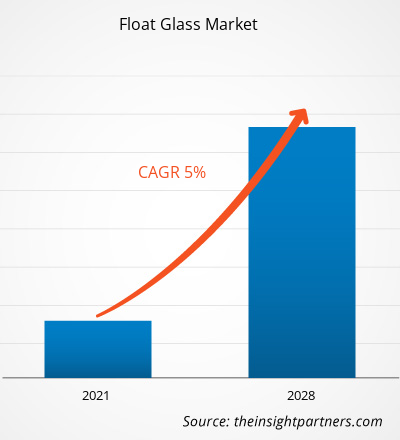Der Floatglasmarkt wurde im Jahr 2020 auf 73.897,83 Millionen US-Dollar geschätzt und soll bis 2028 107.991,35 Millionen US-Dollar erreichen; von 2021 bis 2028 wird ein CAGR-Wachstum von 5,0 % erwartet.
Floatglas ist ein extrem glattes und verzerrungsfreies Glas, das in verschiedenen Endverbrauchsbranchen wie Bauwesen, Automobilbau, Elektronik und Solartechnik verwendet wird. Es wird grundsätzlich hergestellt, indem das geschmolzene Glas aus dem Ofen in eine Kammer gegossen wird, die ein Bett aus geschmolzenem Zinn enthält. Die zunehmende Verwendung von Floatglas in der Innenarchitektur und modernen Architektur hat maßgeblich zur steigenden Nachfrage nach Floatglas beigetragen. Es wird auch in anderen Bauanwendungen eingesetzt, darunter Decken- und Bodenbeläge, reflektierendes und beschichtetes Glas, Fenster, Spiegel, Tischplatten und Isolierglas. Darüber hinaus wird erwartet, dass der zunehmende Einsatz von Floatglas im Automobilbereich die Floatglasindustrie im Prognosezeitraum vorantreiben wird.
Im Jahr 2020 hatte der asiatisch-pazifische Raum den größten Anteil am globalen Floatglasmarkt. Die zunehmende Entwicklung des Automobilsektors und des Bausektors treibt die Nachfrage nach Floatglas in der Region an. Der stark etablierte Automobilsektor in Ländern wie China und Indien erhöht ebenfalls die Nachfrage nach Floatglas in diesen Ländern. Darüber hinaus treiben die Entwicklung und die zunehmende Durchdringung der Solarindustrie im asiatisch-pazifischen Raum das Wachstum des Floatglasmarktes in der Region voran.
Passen Sie diesen Bericht Ihren Anforderungen an
Sie erhalten kostenlos Anpassungen an jedem Bericht, einschließlich Teilen dieses Berichts oder einer Analyse auf Länderebene, eines Excel-Datenpakets sowie tolle Angebote und Rabatte für Start-ups und Universitäten.
Floatglasmarkt: Strategische Einblicke

-
Holen Sie sich die wichtigsten Markttrends aus diesem Bericht.Dieses KOSTENLOSE Beispiel umfasst Datenanalysen, die von Markttrends bis hin zu Schätzungen und Prognosen reichen.
Die Schließung verschiedener Produktionsanlagen und Fabriken in Nordamerika, Europa, im asiatisch-pazifischen Raum, Südamerika sowie im Nahen Osten und Afrika aufgrund der COVID-19-Pandemie hat die globale Lieferkette und Fertigungsprozesse, Lieferpläne und den Produktabsatz beeinträchtigt. Darüber hinaus beeinträchtigen die von Ländern in Europa, Asien und Nordamerika verhängten Beschränkungen die Geschäftszusammenarbeit und Partnerschaftsmöglichkeiten. Die anhaltende COVID-19-Pandemie hat erhebliche Auswirkungen auf den Floatglasmarkt. Die Störungen in der Produktion und Lieferkette haben sich negativ auf den Floatglasmarkt ausgewirkt. Der Glasmangel wird voraussichtlich bis 2021 andauern und Störungen in einer Vielzahl von Unternehmen verursachen. Das Glasangebot wird knapper und der Einkauf ist aufgrund verschiedener Probleme, darunter die weltweite Pandemie und internationale Zölle, teurer geworden. Infolge der globalen Pandemie mussten viele Fabriken und Hersteller die Glasproduktion aussetzen oder verlangsamen, was es äußerst schwierig macht, die aktuelle Nachfrage zu befriedigen. Die Wiederinbetriebnahme von Fabriken nach längerer Schließung oder Produktion auf niedrigem Niveau kann außerordentlich schwierig sein, insbesondere wenn die Unternehmen aufgrund von Gesundheits- und Sicherheitsvorschriften nicht mit voller Kapazität arbeiten. Da COVID-19-Impfungen sowohl für die Öffentlichkeit als auch für das Gesundheitswesen hohe Priorität haben, wurde die Glasverfügbarkeit auf die Ursache umgeleitet, was dazu geführt hat, dass Glas für andere Branchen nicht mehr verfügbar war und somit ein Glasmangel auf dem Markt entstand.
Markteinblicke
Steigende Nachfrage aus der Bauindustrie
Floatglas wird in einem Schmelzprozess hergestellt, bei dem recyceltes Glas, Kalk, Quarzsand, Pottasche und Soda in einem Ofen geschmolzen und auf ein Bett aus geschmolzenem Zinn gegossen werden. Floatglas wird zunehmend in der Bauindustrie verwendet, was den Wohn-, Gewerbe- und Industriesektor umfasst. Floatglas zeichnet sich durch eine hohe Lichtdurchlässigkeit, die Möglichkeit zur Herstellung verschiedener Farben und Opazitäten sowie eine gute chemische Inertheit aus, was die Nachfrage in der Bauindustrie erhöht. Floatglas wird für Fenster und Türen im Wohnbereich verwendet und erfüllt sowohl ästhetische als auch funktionale Zwecke. Auch in der Innenarchitektur und modernen Architektur findet es zunehmend Verwendung. Im gewerblichen Bereich ist Floatglas gefragt, da es eine attraktive und pflegeleichte Außenfläche bietet. Floatglas bietet Licht- und Wärmedurchlässigkeit und beeinflusst so den Heiz- und Kühlbedarf eines Gebäudes je nach Jahreszeit und Klima. Aufgrund seiner Transparenz, Härte und einfachen Reinigung wird Floatglas auch als Schaufenster im Einzelhandel eingesetzt. Aufgrund des zunehmenden Umweltbewusstseins steigt die Nachfrage nach Floatglas in der Bauindustrie, da es zur Erlangung der LEED-Zertifizierung (Leadership in Energy and Environment Design) für Wohn- und Gewerbebauten beiträgt. Das steigende Verbraucherbewusstsein für die Sicherheit von Gebäuden und die zunehmende Fokussierung auf die Einhaltung staatlicher Bauvorschriften dürften die Nachfrage nach Floatglas weiter steigern. Somit wird die steigende Nachfrage nach Floatglas aus der Bauindustrie das Wachstum des Floatglasmarktes im Prognosezeitraum ankurbeln.
Typ-Einblicke
Basierend auf dem Typ ist der Floatglasmarkt in Klarglas, getöntes Glas, Strukturglas und andere segmentiert. Das Klarglassegment hatte 2020 den größten Marktanteil. Klarglas ist Floatglas, das transparent und frei von Defekten und optischen Verzerrungen ist. Klares Floatglas bietet im Vergleich zu anderen Floatglasarten eine überlegene Qualität aufgrund seiner einzigartigen Eigenschaften, wie z. B. verbesserte Oberflächenbearbeitung, gleichmäßige Dicke, hohe optische Qualität, Ebenheit und helles Erscheinungsbild. Es wird in Bereichen eingesetzt, in denen hohe Sichtbarkeit und Klarheit erforderlich sind, wie z. B. Fenster, Türen, Spiegel, Gewächshäuser, Oberlichter, Geräte und Solarien. Da Klarglas frei von optischen Verzerrungen oder kleinen Defekten ist, ermöglicht es eine perfekte Sicht. Das Glas wird auch zur Weiterverarbeitung zur Herstellung anderer Glasarten verwendet.
Einige der wichtigsten Marktteilnehmer auf dem Floatglasmarkt sind AGC Inc.; Nippon Sheet Glass Co., LTD (NSG Group); Xinyi Glass Holdings Limited; SCHOTT AG; Guardian Industries Holdings; Cardinal Glass Industries, Inc.; China Glass Holdings Limited; Shenzhen Sun Global Glass Co. Ltd.; Saint Gobain Glass India; und Qingdao Migo Glass Co. Ltd. Wichtige Akteure auf dem Markt verfolgen Strategien wie Fusionen und Übernahmen sowie Produkteinführungen, um ihre geografische Präsenz und Kundenbasis zu erweitern.
Floatglasmarkt
Die Analysten von The Insight Partners haben die regionalen Trends und Faktoren, die den Floatglasmarkt im Prognosezeitraum beeinflussen, ausführlich erläutert. In diesem Abschnitt werden auch die Marktsegmente und die geografische Lage in Nordamerika, Europa, dem asiatisch-pazifischen Raum, dem Nahen Osten und Afrika sowie Süd- und Mittelamerika erörtert.Umfang des Floatglas-Marktberichts
| Berichtsattribut | Einzelheiten |
|---|---|
| Marktgröße in 2020 | US$ 73.9 Billion |
| Marktgröße nach 2028 | US$ 107.99 Billion |
| Globale CAGR (2020 - 2028) | 5.0% |
| Historische Daten | 2018-2019 |
| Prognosezeitraum | 2021-2028 |
| Abgedeckte Segmente |
By Typ
|
| Abgedeckte Regionen und Länder |
Nordamerika
|
| Marktführer und wichtige Unternehmensprofile |
|
Dichte der Marktteilnehmer im Floatglas-Markt: Verständnis ihrer Auswirkungen auf die Geschäftsdynamik
Der Floatglasmarkt wächst rasant, angetrieben durch die steigende Endverbrauchernachfrage aufgrund von Faktoren wie sich entwickelnden Verbraucherpräferenzen, technologischem Fortschritt und einem stärkeren Bewusstsein für die Produktvorteile. Mit steigender Nachfrage erweitern Unternehmen ihr Angebot, entwickeln Innovationen, um den Verbraucherbedürfnissen gerecht zu werden, und nutzen neue Trends, was das Marktwachstum weiter ankurbelt.

- Holen Sie sich die Floatglasmarkt Übersicht der wichtigsten Akteure
Bericht-Spotlights
- Progressive Trends in der Floatglasindustrie, um Akteuren bei der Entwicklung effektiver langfristiger Strategien zu helfen
- Geschäftswachstumsstrategien, die von Unternehmen übernommen werden, um Wachstum in entwickelten und sich entwickelnden Märkten zu sichern
- Quantitative Analyse des globalen Floatglasmarktes von 2019 bis 2028
- Schätzung der Nachfrage nach Floatglas in verschiedenen Branchen
- Porter-Analyse, um die Wirksamkeit von Käufern und Lieferanten, die in der Branche tätig sind, zur Vorhersage des Marktwachstums zu veranschaulichen
- Jüngste Entwicklungen, um das Wettbewerbsszenario des Marktes und die Nachfrage nach Floatglas zu verstehen
- Markttrends und -aussichten in Verbindung mit Faktoren, die das Wachstum des Floatglasmarktes vorantreiben und hemmen
- Verständnis der Strategien, die das kommerzielle Interesse im Hinblick auf das Wachstum des globalen Floatglasmarktes untermauern, als Unterstützung des Entscheidungsprozesses
- Floatglasmarktgröße an verschiedenen Marktknotenpunkten
- Detaillierte Übersicht und Segmentierung des globalen Floatglasmarktes sowie seine Branchendynamik
- Floatglasmarktgröße in verschiedenen Regionen mit vielversprechenden Wachstumschancen
Floatglasmarkt nach Typ
- Klarglas
- Getöntes Glas
- Strukturiertes Glas
- Sonstige
Floatglasmarkt nach Anwendung
- Automobil und Transport
- Bauwesen
- Elektronik
- Sonstige
Firmenprofile
- AGC Inc.
- Nippon Sheet Glass Co., LTD (NSG Group)
- Xinyi Glass Holdings Limited
- SCHOTT AG
- Guardian Industries Beteiligungen
- Cardinal Glass Industries, Inc.
- China Glass Holdings Limited
- Shenzhen Sun Global Glass Co. Ltd.
- Saint Gobain Glass India
- Qingdao Migo Glass Co. Ltd
- Historische Analyse (2 Jahre), Basisjahr, Prognose (7 Jahre) mit CAGR
- PEST- und SWOT-Analyse
- Marktgröße Wert/Volumen – Global, Regional, Land
- Branchen- und Wettbewerbslandschaft
- Excel-Datensatz
Aktuelle Berichte
Verwandte Berichte
Erfahrungsberichte
Grund zum Kauf
- Fundierte Entscheidungsfindung
- Marktdynamik verstehen
- Wettbewerbsanalyse
- Kundeneinblicke
- Marktprognosen
- Risikominimierung
- Strategische Planung
- Investitionsbegründung
- Identifizierung neuer Märkte
- Verbesserung von Marketingstrategien
- Steigerung der Betriebseffizienz
- Anpassung an regulatorische Trends






















 Kostenlose Probe anfordern für - Floatglasmarkt
Kostenlose Probe anfordern für - Floatglasmarkt